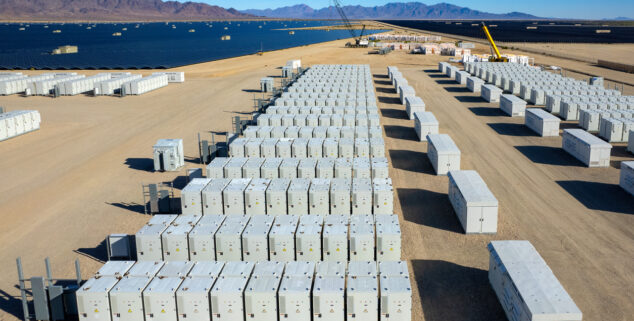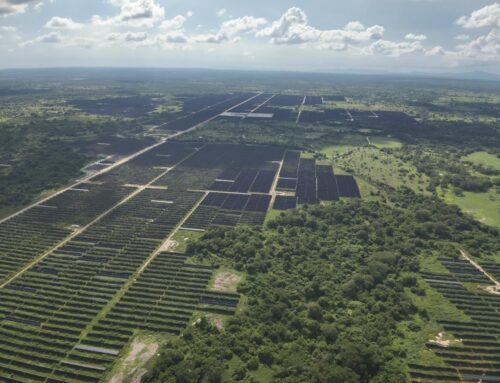Large-scale battery storage key to California’s clean energy future
April 3, 2025
Opinion
 Industrial battery units storing electricity in the desert. Image by The Desert Photo.
Industrial battery units storing electricity in the desert. Image by The Desert Photo.by
ALEX JACKSON and SCOTT MURTISHAW posted 04.03.2025
OPINION – California is at a crossroads in its pursuit of a cleaner, more resilient energy future. As the world’s fifth-largest economy and a leader in climate action, the state has set ambitious goals to reduce greenhouse gas emissions, eliminate fossil fuels, and transition to 100% clean energy by 2045. Achieving these goals requires more than just expanding solar and wind power, which are crucial sources of clean energy but aren’t always available.
That’s where large-scale battery storage comes in. Energy storage unlocks the full potential of renewables and ensures a reliable grid for every Californian. These batteries are revolutionizing how we think about energy by making intermittent renewable sources like solar and wind reliable, flexible, and available whenever we need them. Large-scale batteries store excess energy that’s generated when it’s sunny or windy, and discharge that energy when demand is high, but the sun isn’t shining or the wind isn’t blowing.
At the start of 2019, California’s large-scale battery storage capacity stood at just 330 megawatts, enough to power around 450,000 homes. Since then, the state has made a remarkable leap forward. Today, California has over 11,000 megawatts of large-scale energy storage capacity—enough to meet more than 20% of the state’s peak demand for electricity. Another 2,000 megawatts of energy storage at homes and businesses helps reduce strain on the grid. Over the next two decades, California plans to quadruple its energy storage capacity to about 52,000 megawatts by 2045.
Battery storage has provided transformative benefits. In 2020, California suffered its first blackouts since the 2000-2001 electricity crisis. On September 6, 2022, the state avoided more blackouts despite experiencing its all-time peak electricity demand thanks to the addition of 5,000 megawatts of large-scale energy storage. As demand for power spiked, battery storage provided the backup power the grid needed, surpassing the Diablo Canyon nuclear plant’s output in certain hours. Battery storage provided the state’s safety net during this extreme event, keeping the lights on when needed most.
While battery storage has proven to be a gamechanger in terms of grid reliability and clean energy integration, the industry has faced some challenges as it scales up. Fires at a few facilities have triggered critical conversations and catalyzed significant improvements in industry standards and safety practices.
Energy storage has made significant strides in addressing safety concerns. From 2018 to 2023, the frequency of incidents per unit of storage worldwide dropped by 97%. This progress is a direct result of incorporating lessons learned from early incidents, such as improved technology, better construction practices, and the creation of stricter state and national standards. For example, project developers currently use individual containers of batteries that are spaced apart to minimize the magnitude of fires by limiting fires to one container, reducing the risk to people and the surrounding environment.
Furthermore, California has taken several steps to enhance energy storage safety. A 2023 law requires storage operators to confer with local communities and provide emergency response plans to coordinate actions in the event of an incident. The California Public Utility Commission recently adopted a program that requires energy storage operators to submit safety records and allows the agency to inspect and audit energy storage facilities. Regulators are also incorporating new energy storage safety standards into California’s fire code.
More work remains. We must ensure that all new storage facilities adhere to the highest safety standards and that all facilities conduct robust testing and periodic risk analyses to determine whether additional fire prevention measures are needed.
As California’s clean energy transition accelerates, the importance of large-scale battery storage will continue to grow. These systems are key to reducing the state’s reliance on fossil fuels, mitigating the impacts of climate change, and ensuring a reliable energy supply in a rapidly changing world. For battery storage to reach its full potential, the state must continue to invest in this essential technology while prioritizing safety and innovation.
California leads the nation in energy storage. We must maintain this momentum. With continued improvements in technology and regulatory oversight, energy storage can continue to play a pivotal role in powering the state’s clean energy future.
Let’s ensure that as we build a greener, more resilient grid, we also create a safer one. Future generations deserve the benefits of a cleaner, more sustainable California.
Alex Jackson is the Executive Director of American Clean Power-California, a trade association that represents developers and operators of renewable energy, energy storage, and electricity transmission assets.
Scott Murtishaw is the Executive Director of the California Energy Storage Alliance, a trade association that represents manufacturers, developers, and operators of large-scale and customer-sited energy storage.
Want to see more stories like this? Sign up for The Roundup,
the free daily newsletter about California politics from the editors of Capitol Weekly.
Stay up to date on the news you need to know.
Sign up below, then look for a confirmation email in your inbox.
Search
RECENT PRESS RELEASES
Related Post



